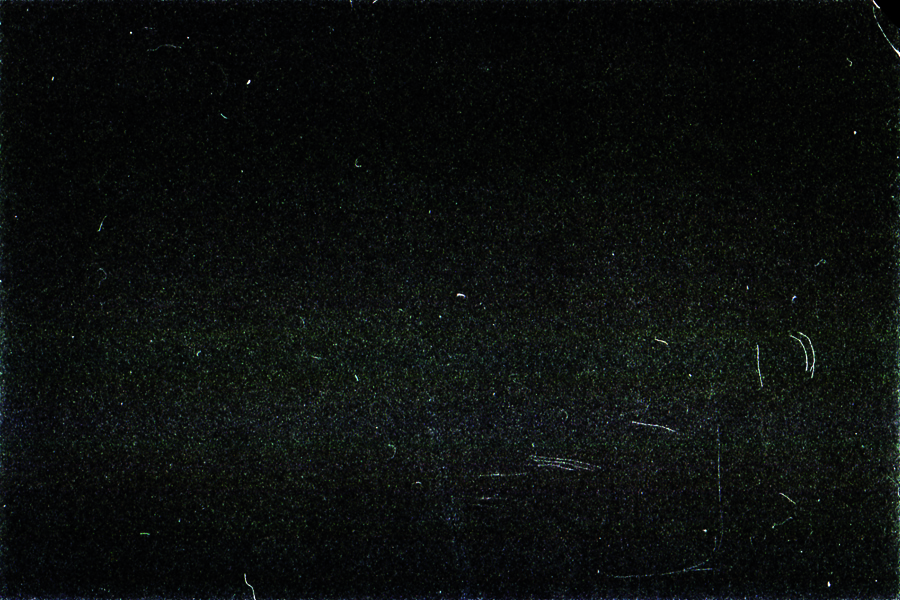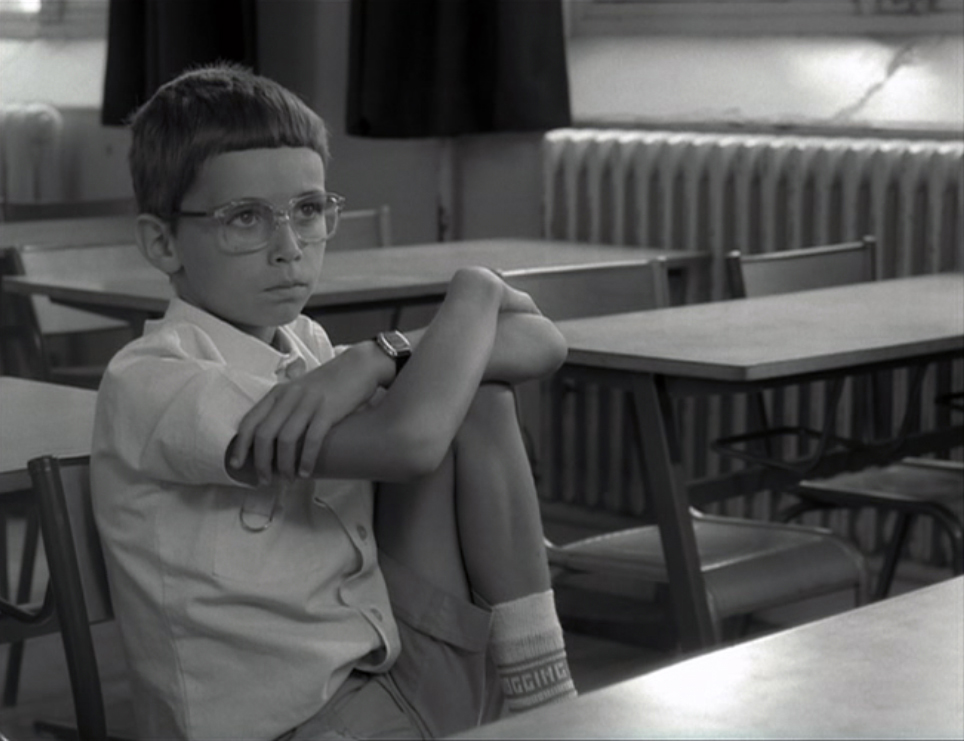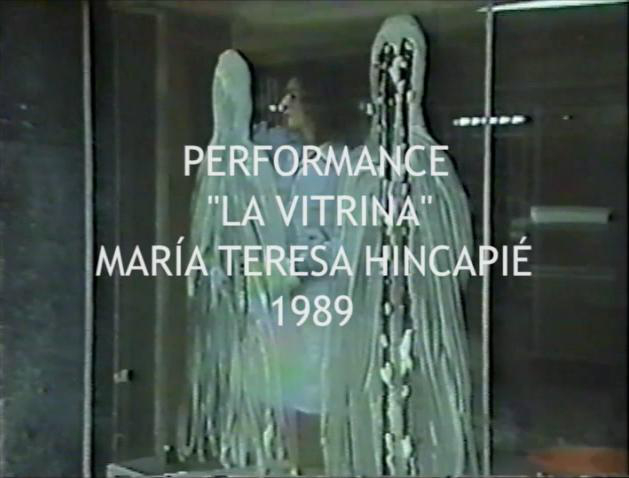
© » KADIST
María Teresa Hincapié
In the performance video Vitrina , María Teresa Hincapié stood inside a storefront window in downtown Bogota, unannounced, for eight hours a day, wearing a uniform and initially carrying out cleaning chores. As the day and passers went by, the routine became more playful: she would send kisses to bus drivers on the busy Avenida Jiménez who would return them, use the newspaper with which she was shining the glass to flirtatiously hide and engage with an improvised audience or draw the shape of her body with soap and a sponge. She would interrupt these chores to carry out other ‘feminine’ activities, like brushing her hair or applying make-up, only to return to frantically cleaning the transparent surface that separated her from the public.
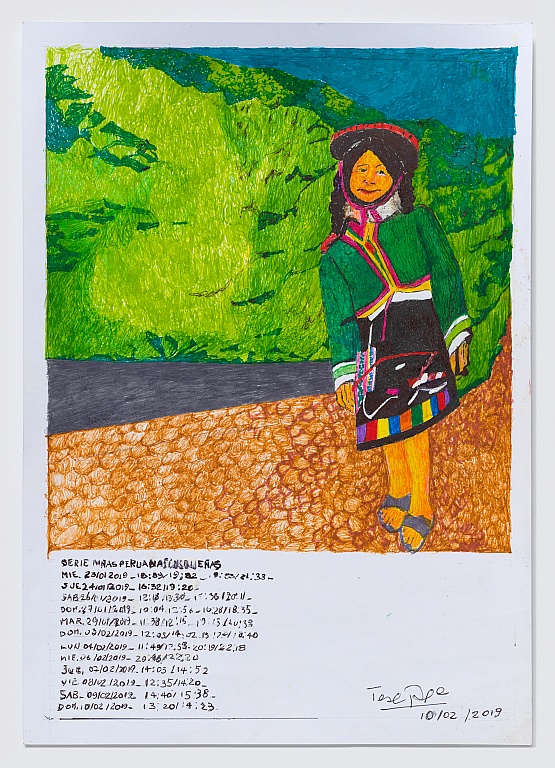
© » KADIST
Teresa Burga
Drawing & Print (Drawing & Print)
In her new series titled Ninas Peruanas Cusquenas , Teresa Burga depicts young indigenous women from Peru’s Andean region, dressed in traditional garments. Sourcing imagery from the internet, the drawings recall an untitled series of drawings from 1974, in which Burga selected images of women at random from various print media, and then rendered the images on paper. Those drawings, like the newer ones, suggest the perils of images without context––how assumptions are made, stereotypes are formed, and knowledge is gathered.
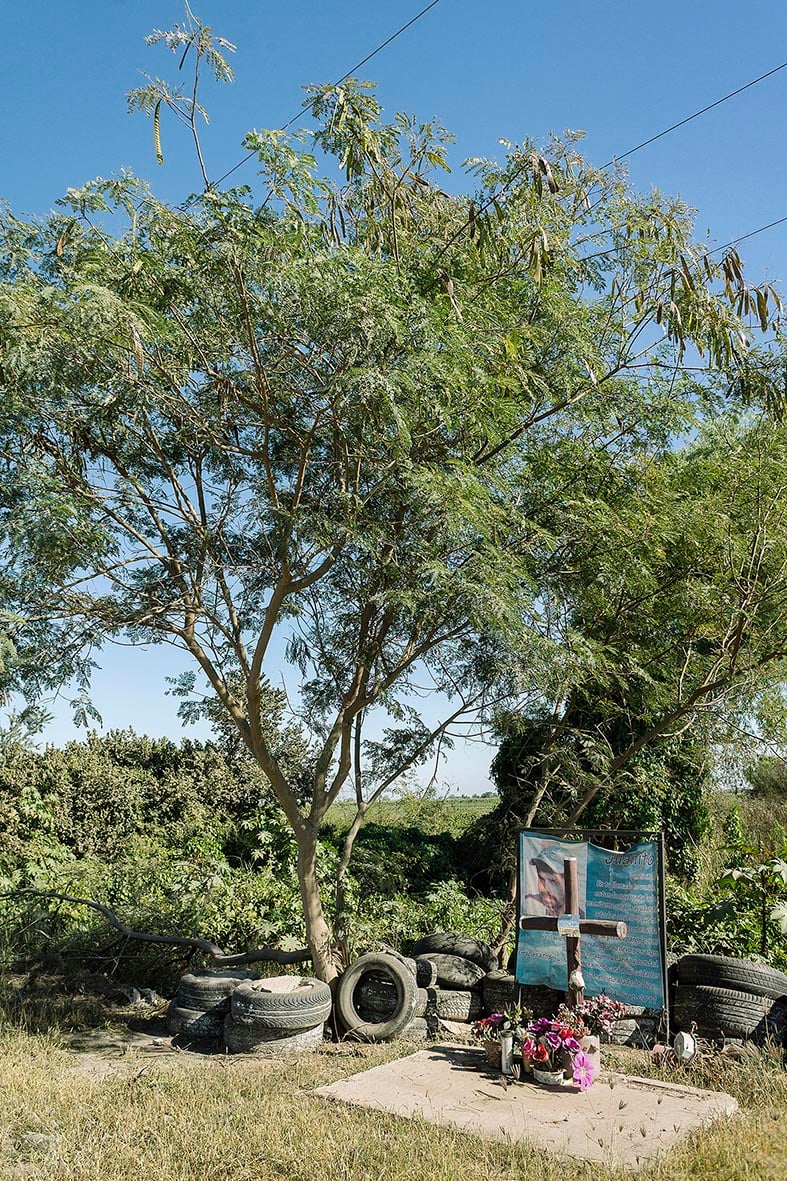
© » KADIST
Teresa Margolles
Stretching between San Pedro and the beach in Altata, Sinaloa, there is a 40 km road where there are three invisible borders controlled by rivalling armed groups. There is a price to pay for crossing these territories. This series of 21 photographs by Teresa Margolles, titled 40 Km , resemble snapshots of peaceful lands, but also bear witness to the reality lived by the local people in this area.

© » KADIST
Maria Taniguchi
Untitled (Celestial Motors) is a visual meditation on an icon of modern urban Philippine life—the jeepney. This ubiquitous form of public transportation, originally built from U. S. military jeeps left on the islands after World War II, is normally exuberantly painted and personalized. They are known for their crowded seating and kitsch decorations, which have become an omnipresent symbol of Philippine culture.

© » KADIST
Maria Bussman
Drawing & Print (Drawing & Print)
The drawing “Heidegger’s Cabin” (2005) is inspired by Martin Heidegger’s essay, “The Origin of the Work of Art.” During the artist’s stay in a high alpine area, near a lake reservoir, Bussmann related the landscape in her surroundings to her reading of Heidegger’s terms on the work of art and the meaning of a “thing.” In attempt to link spiritual heights to natural heights, Bussmann metaphorically relates the subjects of being and truth to a hiking path, and its different degrees of challenge and risk. In the drawings rather than finding the optimal path to reach ultimate meaning and materialization, Bussmann never arrives at “Heidegger’s Cabin,” and instead is led off the beaten track to areas she never discovered before. Upon her return from the mountains in 2004 and 2005, she continued to develop the series, leading up to 20 drawings on handmade paper that attempt to problematize Heidegger’s theory on artworks as “things” as bearers of traits, “things” confronting the world of perception, and “things” as formed matter.

© » KADIST
Maria Taniguchi
Maria Taniguchi works across several media but is principally known for her long-running series of quasi-abstract paintings featuring a stylized brick wall device. Full of subtle gradations and low-key modulations, these are her trademark: a sustained, reiterative practice, steeped in repetition but carefully attuned to the economies and the sculptural presence of painting. Her approach to painting is conceptual.

© » KADIST
Ana Teresa Fernández
Drawing & Print (Drawing & Print)
The artist writes about her work Borrando la Frontera, a performance done at Tijuana/San Diego border: “I visually erased the train rails that serve as a divider between the US and Mexico. I painted them sky blue, creating a “Hole in the Wall” This deconstruction of “feminized” work explores the difficulties in reconciling both low wages and undervalued work via social and political infrastructures, confronting issues of labor and power. The images that I myself perform, present a duality: women dressed in a black tango dance attire while engaging in de-skilled domestic chores; the surreal within non-fiction.

© » KADIST
María Buenaventura
The Territory is not for sale is a process of reflection and research with people, thinkers and community leaders from Usme, a rural part of Bogotá on the tenuous verge of becoming urban. As an art object and installation, it comprises multiple stacks of paper each containing the decrees of land expropriation from many different peasant farmers who are being forced to sell their lots of land back to the government. Usme lies at the southern urban-rural border strategically located next to the Páramo de Sumapaz, an enormous neo-tropical tundra ecosystem and water reserve.
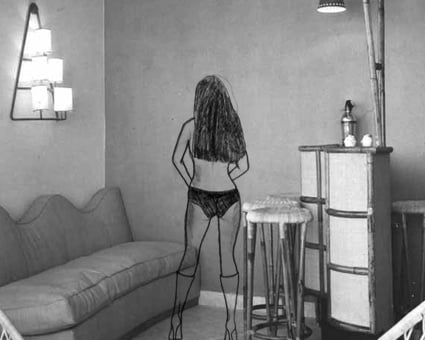
© » KADIST
Marwa Arsanios
I’ve heard stories (2008) is one of Marwa Arsanios early works. It is a short animated film staging a story that took place at the Carlton hotel in Beirut. This work is the first part of a longer project on this iconic building.

© » KADIST
Daria Martin
Soft Materials is a curious, touching but also disturbing sequence of confrontations between two people: a man and a woman, and machines. Shot in the Artificial Intelligence Laboratory at the University of Zurich, the humans and the machines mirror each other’s actions. It is unclear which party takes the lead.
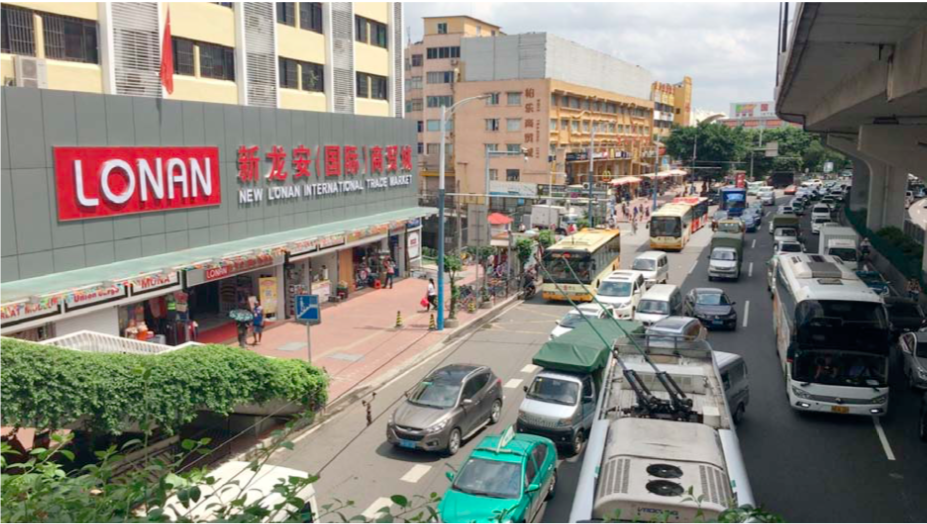
© » KADIST
Marie Voignier
“Na China” means “In China” in Igbo language. Marie Voignier’s film NA CHINA! focuses on the African women communities who have emigrated to Guangzhou, in the southeast of China.
![Elevación [Elevation]](https://kadist.org/wp-content/uploads/2022/09/IMG_escena001_3513-scaled.jpg)
© » KADIST
Ana María Millán
Interested in role-play and videogames, Ana María Millán developed workshops with different communities in order to create characters and scenarios for her animations, often in collaboration with a choreographer. Elevación evokes various narratives inspired by the comicstrip Marquetalia, Raíces de la Resistencia (Marquetalia, Roots of the Resistance) (2011). This comic strip is a memoir of the FARC (Revolutionary Armed Forces of Colombia) guerillas written by Jesús Santrich, one of its leaders who, after the 2016 Peace Agreement, rejoined dissident members of the organization in a clandestine guerrilla splinter group in 2019.

© » KADIST
María Isabel Rueda
The Real. Retrato de Norman Mejía. (The Real. A Portrait of Norman Mejía.)

© » KADIST
Rajni Perera
Drought Mask by Rajni Perera is a prototype that is suggestive of dire implications for human survival. Directly addressing the urgent climate crisis, specifically wide-spread drought, this sculpture imagines hybrid cultural aesthetics of the near-future after global collapse. Composed of various woven textiles complete with frills and fringes, leather, a gas mask, and pencil, Rajni’s mask prefigures future dystopian characters who are resilient and resourceful; self-fashioning tools for survival.

© » KADIST
Ron Terada
Drawing & Print (Drawing & Print)
The three Maiko s were included in Ron Terada’s 2008 exhibition, Voight–Kampf , at Catriona Jeffries gallery. More ambitious in size and subject matter, this show with its complex video installation marked a new path for Terada’s work. Voight-Kampf is based on a scene from Ridley Scott’s 1982 movie Blade Runner in which a giant advertising billboard in the midst of a dystopian city of Los Angeles in the future displays a geisha eating candy.
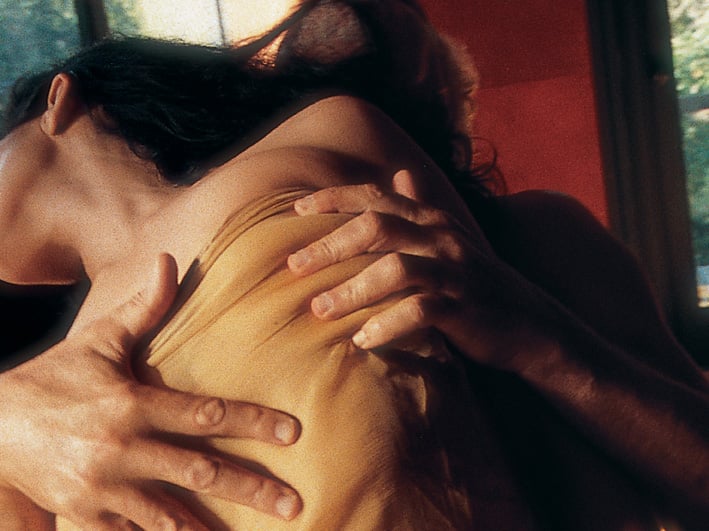
© » KADIST
Daria Martin
In keeping with her mythological proclivity, Minotaur (2009) casts a new light on an old narrative. The film takes the ancient Greek story of the half-man, half-bull as its title subject, but at its core, Minotaur is an homage to pioneering modern dancer and choreographer, Anna Halprin. Along with Trisha Brown, Simone Forti, and Yvonne Rainer, Halprin’s fearless and lifelong dance practice paved the way for the evolution of modern and contemporary dance as we understand it today.
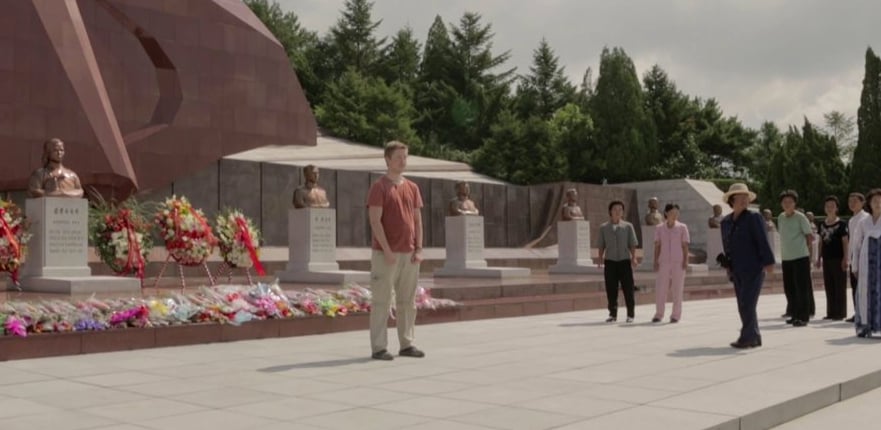
© » KADIST
Marie Voignier
Tourisme International was shot as the recording of a show on the scale of a country. In the urgency of perpetual travel, this tourist journey visits monuments, museums, institutions presented by North Korean guides whose voices we do not hear. Marie Voignier entirely redesigned the sound of each sequence in post-synchronization, making only the living experiences of footsteps and rustling of clothes audible, to create a new universe, disconnected from the official discourses.

© » KADIST
Marina Rosenfeld
The installation Music Stands: Free Exercise 7, 8, and 9 by Marina Rosenfeld consists of music stand-like structures and a corresponding set of panels and acoustic devices that direct, focus, obstruct, reflect and project sound in the gallery. Together the components play on the connection between aural and social relations signified by the music stands. An episodic score emanates from the work’s sound system, momentarily interrupting the atmosphere with brief eruptions of electronic sounds and vocality.

© » KADIST
Marwa Arsanios
Carlton Hotel project is the second part of a research on the Carlton, an iconic building of modernist architecture from the 1960s in Beirut. Designed by Polish architect Karol Shayer, it was destroyed in 2008 (date of the project’s creation). This project is multifaceted, always transforming into different forms and involving a series of collaborations: the first step took place as part of the “traveling curtains project”, which consisted in recuperating the curtains from the Carlton hotel before its demolition and sending them to different cities throughout the world where they would be subject to new interventions and transformations by artists, among whom Marwa Arsanios.

© » KADIST
Maria Fernanda Plata
Unraveling, or “unweaving” sections of fabric, Maria Fernanda Plata arrived at delicate and tenuous-looking forms, both ghostly and gentle. Her careful meditations in fabric reflect Plata’s ongoing interest in the relationship between people and their environments, in fragility, systems, and destruction.

© » KADIST
Aria Dean
Although typically sold today as a novelty item for flower arrangements and interior decorating flourishes, cotton can also be seen as a proxy, through synecdoche, for US slavery. Dead Zone (4) by Aria Dean presents a preserved blossom of that trade’s primary cash crop, cotton, crystalized in a state of non-decay whilst encased under protective glass. Hidden in the base of the work is a signal jammer which prevents mobile phones from broadcasting when nearby.

© » KADIST
Tessa Mars
In this untitled acrylic painting, Tessa Mars explores the long-lasting effects of colonialism on the Afro-Caribbean diaspora, particularly in terms of female vulnerability and resilience. Drawing on her interest in retelling stories of her native country, and confronting the past and the present, Mars portrays her cultural essence and heritage by imagining spiritual spaces that connect people and land across time. With a pictorial practice that highlights pastel colors, the divinisation of the figures on the canvas and the spiritual elements within the composition ultimately enhance the narrative of her Caribbean ancestry while conflating the distinctions between autobiographical and historical events.

© » KADIST
Mario Garcia Torres
In Up All Night, Waiting for the Chelsea Hotel Magic to Spark My Creativity Mario García Torres constructs and documents a hypothetical scene, situating himself within a lineage of artists and creatives that used to congregate at the historic hotel. The long-exposure capture depicts García Torres at multiple stages of brainstorming, devising, and introspection, his ethereal figure connected with artistic giants of the past. Yet, there is also an insipid tone beyond mere insomnia or frustration at the lack of being able to garner inspiration.

© » KADIST
Mario Ybarra Jr.
Ammo Bunker (2009) is a multipart installation that includes large-scale wall prints and an architectural model. The work takes as its departure point the history of Wilmington, Ybarra’s native hometown in southern Los Angeles. The piece refers to a Civil War era ammunition store that Ybarra found at the heart of the harbor close to Long Beach.

© » KADIST
Mario Garcia Torres
Mario Garcia Torres films a game of Charades among professional actors guessing the former North Korean dictator’s favorite Hollywood films. Indeed rather surprisingly Kim seems to have had a huge collection of Western videos and he published a book called “On the art of the Cinema” in 1973. As the final acknowledgments indicate, Garcia Torres’s work was produced following in depth research, consulting information given by director Shin Sang-ok who has been kidnapped by Kim in 1978, as well as Jerrold Post (The George Washington University) and Timothy Savage (Nautilus Institute for Security and Sustainable Development).

© » KADIST
Mario Garcia Torres
Mario Garcia Torres imagines cinematic devices to replay stories occasionally forgotten by Conceptual art. For him, this is a way of rethinking the tradition in a more personal way, to have a grip on events of recent history and examine them with a curiosity, both critical and sensual. The artist emphasizes the fact that new ideas and meanings may arise from these archaeological narratives.

© » KADIST
Mario Garcia Torres
Mario Garcia Torres discovered the work of artist Oscar Neuestern in an article published in ARTnews in 1969. This article, which is the only trace of his work, is indicative of a lack of interest by Neuestern to leave his name in history; to “defend an artistic activity that has little or no interest to last.” Oscar Neuestern could only remember the previous 24 hours, of which his life and his work are in constant erasure and reconstruction. His practice was “to let things be done with time and the unconscious,” while “not fearing the void.” He looked for the absolute through transparency and symmetry.

© » KADIST
Alejandro Almanza Pereda
This still life falls apart, or rather floats apart as the composition is proved unstable and constantly morphing. An impossible attempt at achieving a fixed state, some objects remain buoyant and some objects sink, constantly tilting the overall scale and arrangement. Properties of weight, mass and shape have their own will but a hand appears in the scene, pushing back on these mysterious forces.

© » KADIST
João Maria Gusmão and Pedro Paiva
The artist duo João Maria Gusmão and Pedro Paiva traveled to Japan for a month to make a series of short 16mm films, often shot in slow-motion. This film, shown in continuous loop, has a run-time of just under 3 minutes, and is presented without sound. It captures a traditional Shisa (combination of a dog and lion from Okinawan mythology) animated by an invisible person.
Mario Garcia Torres
- location: Mexico City, Mexico
- year born: 1975
- gender: male
- nationality: Mexican
- home town: Monclova, Mexico
Maria Taniguchi
Throughout her paintings, sculptures, and videos, Maria Taniguchi unpacks knowledge and experience—connecting material culture, technology, and natural evolution—and investigates space and time, along with social and historical contexts...
Marie Voignier
Marie Voignier’s work presents a subtle criticism of the transitory status of action within the social and political elds...
Marwa Arsanios
Marwa Arsanios is born in 1978 in Washington, United-States...
Daria Martin
A number of Daria Martin’s films explore the relationship between humans and machines and make reference to modernist art, whether through the work of the Bauhuas (Schlemmer), Surrealism (Giacometti’s Palace at 4 AM) or American art of the 1960s and 1970s...
Teresa Margolles
Teresa Margolles’s work examines the social causes and consequences of violence...
Rajni Perera
Rajni Perera’s practice foregrounds a hybrid model that merges immigrant politics, feminine power, mythology, and science fiction...
Maria Bussman
Maria Bussmann’s works represent an insistent attempt to fathom the epistemological quality of her medium, drawing...
Maria Fernanda Plata
Colombian artist Maria Fernanda Plata found herself drawn to fabric as a material with conceptual implications while on a residency in Vietnam...
Etel Adnan and Lynn Marie Kirby
Visual artist, poet, and essayist Etel Adnan writes what must be communicated through language, and paints what cannot...
Ron Terada
Ron Terada belongs to a generation of Vancouver-based artists that follows the well-known Vancouver School of photoconceptualists which includes Jeff Wall, Stan Douglas, and Ian Wallace...
Teresa Burga
A pioneer of Latin American Conceptualism, since the 1960s, Teresa Burga has made works that encompass drawing, painting, sculpture, and conceptual structures that support the display of analytical data and experimental methodologies...
Mario Ybarra Jr.
- location: Los Angeles, California
- year born: 1973
- gender: male
- nationality: American
- home town: Los Angeles, California
Aria Dean
Through art, text, and exhibition making, Aria Dean analyzes the structure and circulation of images and subjectivities in relation to material, cultural histories, and technology...
Tessa Mars
Tessa Mars delves into Haitian history, her primary source of inspiration, to unveil a colourful and provocative universe that she wishes to reclaim...
Marina Rosenfeld
Marina Rosenfeld is a New York-based composer and artist working across disciplines...
Alejandro Almanza Pereda
Alejandro Almanza Pereda has a heightened understanding of the essence of objects...
-
1980-1989
Jean-Marie Straub and Danièle Huillet
1982En rachâchant is based on the short story Ah! Ernesto! (1971) by Marguerite Duras in which the child Ernesto does not want to go to school anymore as all that he is taught are things he does not know...
María Teresa Hincapié
1989In the performance video Vitrina , María Teresa Hincapié stood inside a storefront window in downtown Bogota, unannounced, for eight hours a day, wearing a uniform and initially carrying out cleaning chores...
-
2000-2009
Daria Martin
2004Soft Materials is a curious, touching but also disturbing sequence of confrontations between two people: a man and a woman, and machines...
Mario Garcia Torres
2004Mario Garcia Torres imagines cinematic devices to replay stories occasionally forgotten by Conceptual art...
Maria Bussman
Drawing & Print
2005(Drawing & Print) The drawing “Heidegger’s Cabin” (2005) is inspired by Martin Heidegger’s essay, “The Origin of the Work of Art.” During the artist’s stay in a high alpine area, near a lake reservoir, Bussmann related the landscape in her surroundings to her reading of Heidegger’s terms on the work of art and the meaning of a “thing.” In attempt to link spiritual heights to natural heights, Bussmann metaphorically relates the subjects of being and truth to a hiking path, and its different degrees of challenge and risk...
Mario Garcia Torres
2005Mario Garcia Torres films a game of Charades among professional actors guessing the former North Korean dictator’s favorite Hollywood films...
Ron Terada
Drawing & Print
2008(Drawing & Print) The three Maiko s were included in Ron Terada’s 2008 exhibition, Voight–Kampf , at Catriona Jeffries gallery...
Daria Martin
2008In keeping with her mythological proclivity, Minotaur (2009) casts a new light on an old narrative...
Marwa Arsanios
2008Carlton Hotel project is the second part of a research on the Carlton, an iconic building of modernist architecture from the 1960s in Beirut...
Mario Ybarra Jr.
2009Ammo Bunker (2009) is a multipart installation that includes large-scale wall prints and an architectural model...
-
2010-2019
Mario Garcia Torres
2010In Up All Night, Waiting for the Chelsea Hotel Magic to Spark My Creativity Mario García Torres constructs and documents a hypothetical scene, situating himself within a lineage of artists and creatives that used to congregate at the historic hotel...
Ana Teresa Fernández
Drawing & Print
2011(Drawing & Print) The artist writes about her work Borrando la Frontera, a performance done at Tijuana/San Diego border: “I visually erased the train rails that serve as a divider between the US and Mexico...
María Buenaventura
2011The Territory is not for sale is a process of reflection and research with people, thinkers and community leaders from Usme, a rural part of Bogotá on the tenuous verge of becoming urban...
Maria Taniguchi
2012Untitled (Celestial Motors) is a visual meditation on an icon of modern urban Philippine life—the jeepney...
Teresa Margolles
2014Stretching between San Pedro and the beach in Altata, Sinaloa, there is a 40 km road where there are three invisible borders controlled by rivalling armed groups...
Marie Voignier
2014Tourisme International was shot as the recording of a show on the scale of a country...
Maria Taniguchi
2015Maria Taniguchi works across several media but is principally known for her long-running series of quasi-abstract paintings featuring a stylized brick wall device...
Maria Fernanda Plata
2015Unraveling, or “unweaving” sections of fabric, Maria Fernanda Plata arrived at delicate and tenuous-looking forms, both ghostly and gentle...
Alejandro Almanza Pereda
2015This still life falls apart, or rather floats apart as the composition is proved unstable and constantly morphing...
João Maria Gusmão and Pedro Paiva
2015The artist duo João Maria Gusmão and Pedro Paiva traveled to Japan for a month to make a series of short 16mm films, often shot in slow-motion...
Etel Adnan and Lynn Marie Kirby
Drawing & Print
2017(Drawing & Print) In conjunction with KADIST’s 2017 exhibition If Not Apollo, the Breeze , artist and filmmaker Lynn Marie Kirby performed Transmissions , a video and live reading created with longtime collaborator Etel Adnan...
Teresa Burga
Drawing & Print
2019(Drawing & Print) In her new series titled Ninas Peruanas Cusquenas , Teresa Burga depicts young indigenous women from Peru’s Andean region, dressed in traditional garments...
Ana María Millán
2019Interested in role-play and videogames, Ana María Millán developed workshops with different communities in order to create characters and scenarios for her animations, often in collaboration with a choreographer...
Marina Rosenfeld
2019The installation Music Stands: Free Exercise 7, 8, and 9 by Marina Rosenfeld consists of music stand-like structures and a corresponding set of panels and acoustic devices that direct, focus, obstruct, reflect and project sound in the gallery...
-
2020-2029
Rajni Perera
2021Drought Mask by Rajni Perera is a prototype that is suggestive of dire implications for human survival...
Tessa Mars
2022In this untitled acrylic painting, Tessa Mars explores the long-lasting effects of colonialism on the Afro-Caribbean diaspora, particularly in terms of female vulnerability and resilience...
